What to Do When an Amputation Starts Bleeding Again
Bleeding is unremarkably minor in nature but can sometimes impose serious threat if a large vein or avenue has been injured.
External Haemorrhage
Amputation
Crush injury
Nose Bleed
Abrasion (Graze)
Punture wound
Internal Haemorrhage
External bleeding
Background
By and large, bleeding is of a minor nature and includes pocket-sized cuts, grazes, etc.
However, bleeding may exist severe and life threatening if a big vein or artery has been injured – e.g. the jugular vein in the cervix.
Some wounds are associated with other injuries below the skin – e.yard. an organ injured past a stabbing; broken bones which have pierced the skin.
Symptoms and signs – Non all may be present
- a wound with, or without, an embedded foreign object
- hurting from peel surface wounds
- bruising or discolouration of the pare
- loss of normal office in the injured expanse
- stake, common cold, sweaty skin
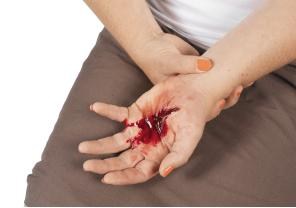
External haemorrhage
How yous can help
1. Utilise direct pressure to the bleeding wound
- Apply firm pressure over the wound. Use a sterile or clean bulky pad and apply it firmly with hand pressure. Employ a bandage to keep the dressing in place.
- If bleeding is severe, Practise Non waste fourth dimension looking for suitable padding, just be prepared to utilise the patient's mitt or your hand to hold the wound together if the patient is unable to do this unaided.
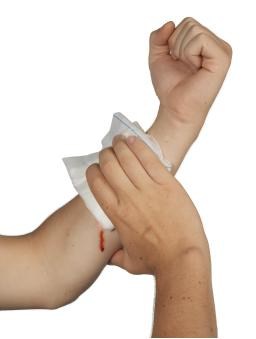
Utilize direct pressure to the haemorrhage wound
2. Raise the injured area
- If the wound is on a limb, raise it in a supported position to reduce blood period to the injured area.
- If an arm is injured, yous could utilize an arm sling or superlative sling.
Try to avoid any direct contact with the patient'southward claret or other torso fluids. Use disposable gloves if possible. If gloves are not bachelor, identify your easily inside a plastic handbag.
- If there has been any contact with blood or whatsoever other body fluids, wash your hands or any blood splashed on the peel thoroughly with soap and water every bit soon every bit possible after the incident.
- If you are concerned most a possible risk of infection, obtain communication from your dr. every bit soon as possible.
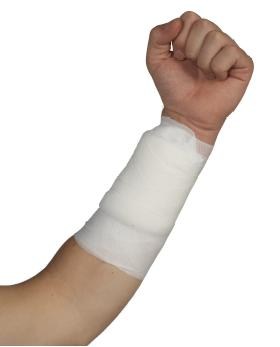
Raise the injured area
3. If a foreign body is embedded in the wound
- DO Non remove it merely apply padding on either side of the object and build it upwards to avert pressure on the foreign body.
- Hold the padding firmly in place with a roller bandage or folded triangular bandage applied in a criss-cross method to avert pressure on the object.
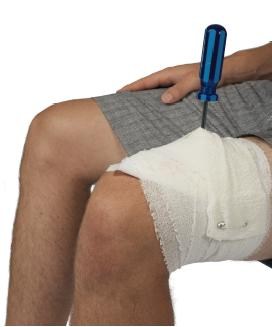
Practise NOT remove the foreign object, simply apply padding on either side.
4. Continue the patient at total rest
- Fifty-fifty if the injury involves the arm or upper part of the body, the patient should rest in a position of greatest comfort for at least 10 minutes to help control the bleeding.
5. Seek medical help
- If the wound appears to be small and the patient is able to travel by auto, arrange an urgent appointment with a local doc to assess and treat the injury.
If the injury is severe or the patient is very unwell – call 111 for an ambulance every bit presently every bit possible.
While waiting for an ambulance to go far, notice the patient closely for any change in condition.
6. If claret leaks through the pressure level pad and bandage
- Utilise a second pad over the outset. Use a tea towel or similar beefy fabric and apply maximum pressure to the surface area.
- For major uncontrolled bleeding quickly remove the claret-soaked pad and bandage and supplant with a fresh bulky pad and bandage. The continuing bleeding may be due to the pad slipping out of position when the first bandage was practical.
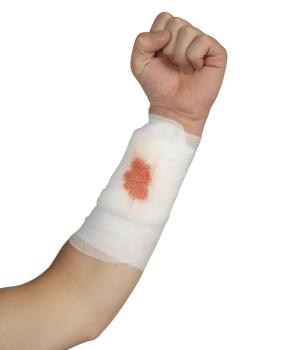
If claret leaks through the pressure pad and bandage
Wounds that need special care
Amputation
How you can aid
Telephone call 111 for an ambulance.
1. Control any bleeding
- Use a beefy pad and apply information technology firmly to the bleeding area. Raise if possible.
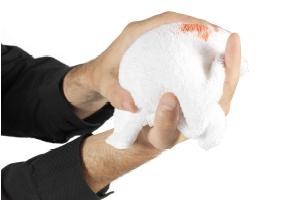
Control any haemorrhage
2. Recover the severed office
- If possible, gently place information technology into a plastic bag. Seal the bag with a lilliputian air inside to protect the severed part with a 'cushion' of air.
- Place the inflated bag into a container or bucket of cold water to which several water ice cubes have been added.
- Ensure the severed part is transferred to hospital with the patient.
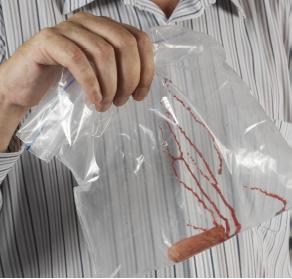
Recover the severed part
Crush injury
Groundwork
A vanquish injury occurs from compression of big musculus groups and soft tissues past a heavy weight. The most serious sites for a beat out injury to occur are the head, neck, chest, abdomen and thigh.
How you can assist
Call 111 for an ambulance.
one. Remove the crushing force
- Remove the crushing forcefulness if possible because permanent tissue damage may occur with severe crushing force.
- If the crushing force has been in place for some time, be prepared to give prompt starting time aid, considering removal of the burdensome force may cause a sudden collapse or deterioration in the patient's condition.
2. Care for the patient's injuries
- Appraise and treat any injuries in order of their importance.
- Command whatsoever bleeding with a sterile pad applied firmly to the injured area.
- Assistance the patient into the position of greatest comfort and employ soft padding to provide support for the injured part.
- If a limb is involved, support and immobilise the injured expanse.
- While waiting for the ambulance to get in, observe the patient closely for whatsoever change in condition.
Nose bleed
Background
A accident to the nose, flying at high altitude, or scuba diving may all cause a bleeding nose.
For a child, ever check whether there is a foreign body present – e.g. a bead or money. If this has occurred, seek prompt medical advice and Practice NOT try to remove the object yourself because this may cause further damage.
If bleeding is due to a head injury – e.g. a fractured skull – call 111 for an ambulance urgently.
How you can help
ane. Use firm pressure level, height and rest
- The patient needs to concord the head well forwards and breathe through the rima oris while pinching the entire soft role of the nose for 10 to twenty minutes.
- The patient must exist sitting down and at total remainder until the bleeding stops.
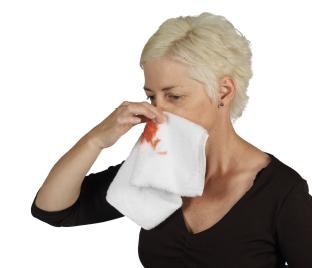
Apply firm pressure, elevation and rest
If bleeding continues after 20 minutes of pressure, continue the pressure and phone call for an ambulance.
A common cold shrink tin exist used.
2. In one case the bleeding has stopped
- Tell the patient non to blow their nose for a few hours because this may restart the bleeding.
Other wounds
An abrasion (graze)
How you tin help
- Gently clean with soapy water or saline. If at that place are pieces of gravel embedded in the wound, enquire the patient to try to remove them while the area is soaking in soapy water.
- Dry out the expanse well by blotting with gauze swabs or a pad of tissues.
- If a protective dressing is necessary, apply a non-adherent sterile dressing and fix it in identify with a light roller bandage or record.
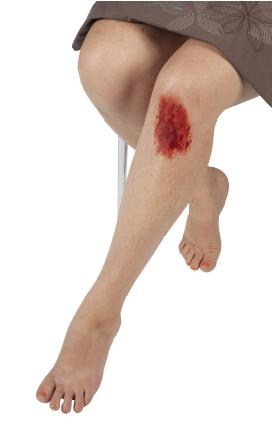
An abrasion (graze)
A puncture wound
How you can help
- Clean the wound with warm soapy water and allow it to penetrate the puncture track because tetanus spores may be trapped deep in the wound.
- Allow the wound to dry thoroughly in the air before roofing it.
- If a protective dressing is needed, use a porous adhesive dressing and change information technology daily to keep the wound healthy and dry.
Contact a local md for communication most tetanus immunisation.
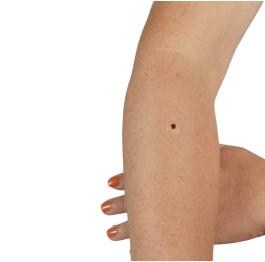
A puncture wound
Internal bleeding
Background
Internal bleeding is often difficult for the first aider to recognise. This type of haemorrhage can
occur without an obvious wound and can be very serious every bit information technology is hard to stop without surgical intervention.
Internal bleeding occurs when blood vessels within the trunk are ruptured and blood escapes
out of the circulatory organization. It may follow such incidents as a accident to the head, breast, or
abdomen due to a fall or being struck by a vehicle. Internal bleeding should exist suspected when claret is seen in vomit, urine, sputum or faeces.
Symptoms and signs – Not all may be nowadays
- rapid and 'gasping' breaths
- increasing thirst
- frothy red blood coughed up from the lungs, blood-stained vomit like 'coffee grounds', red or rust-coloured urine, or night faeces like tar
- stake, common cold, sweaty skin
How you lot can assist
- Place the patient at full rest
- Assist the patient into the position of greatest comfort.
- Comprehend the patient with a blanket to maintain torso rut.
- Identify protective fabric underneath the patient if the surface is rough, cold or hot – eastward.g. a coat if the patient is lying on a road.
Call 111 for an ambulance.
- While waiting for the ambulance
- Manage whatever other injuries.
- Ensure that all restrictive clothing has been loosened, especially at the neck and waist.
- Proceed any bystanders clear.
- Reassure the patient.
- DO Non permit the patient to swallow, potable or smoke.
Take the information on hand when you demand it the nearly.
Buy the First Aid Handbook >>
Learn the applied skills to help save a life.
Volume a first aid grade >>

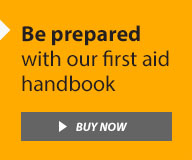


Source: https://www.stjohn.org.nz/first-aid/first-aid-library/bleeding/
0 Response to "What to Do When an Amputation Starts Bleeding Again"
Post a Comment